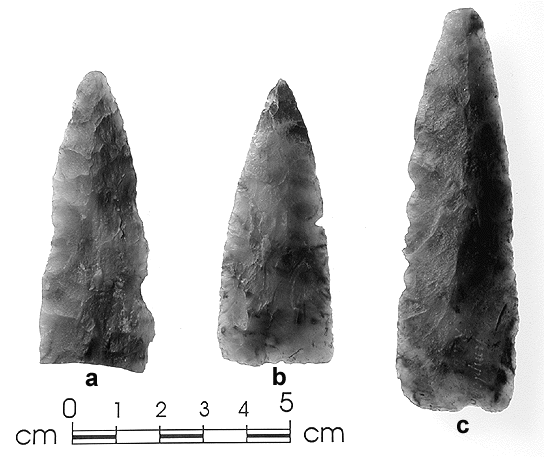Ramah
Quartizite Bifaces
from
the Lower Gatineau River
by Jean-Luc Pilon
The Old System collections at the Canadian Museum of Civilization
were gathered under a variety of circumstances. Some of these collections
were purchased from collectors in the earlier part of the century (a practice
no longer taking place!), others were donated by individuals or organisations
which had acquired substantial numbers of artifacts and could no longer
care for these properly or simply came to the realization that more use
could be made of them if they were in a museum.
These collections quite often contain spectacular examples of intact
pieces. They were collected at a time when the land was still worked
with horses and when farmers walked behind their plows. Opportunity
was thus afforded to notice unusual items being turned up by the plowing.
 As
I prepared to photograph artifacts which had been found in the general
Ottawa-Hull area for a public lecture in early October of 1999, I came
across two artifacts which could fit comfortably in the category of item
known as Meadowood cache blades (b & c). A third is similar but less
well made and incomplete (a). They were found on two separate sites
near the mouth of the Gatineau River. They were eloquent witnesses
to an Early Woodland presence in the region, dating to perhaps 2500-2000
years ago. I therefore prepared to photograph them together.
As
I prepared to photograph artifacts which had been found in the general
Ottawa-Hull area for a public lecture in early October of 1999, I came
across two artifacts which could fit comfortably in the category of item
known as Meadowood cache blades (b & c). A third is similar but less
well made and incomplete (a). They were found on two separate sites
near the mouth of the Gatineau River. They were eloquent witnesses
to an Early Woodland presence in the region, dating to perhaps 2500-2000
years ago. I therefore prepared to photograph them together.
As I did so, I noticed they appeared to be made of the same raw material.
I held one, then the next two up to the light and it became clear to me
that this material was Ramah quartzite; a variable yet distinctive type
of stone which occurs in geological deposits found only on the north Labrador
coast. This stone was used extensively along the Labrador coast throughout
prehistory, beginning with the Early Maritime Archaic some 7000 years ago.
Ramah quartzite was also traded widely south into the Maritimes provinces
and New England, into the St. Lawrence and the interior of Québec
and up along the north coast of Québec along Hudson's Strait.
I recognized it quite easily since Ramah was a common raw material on sites
on many of the archaeological sites I had worked on while a student: in
the Indian House Lake area northeast of Schefferville, Québec, on
sites of Diana Island on the south shore of Hudson Strait and in the Caniapiscau
region of central Québec.
Interestingly, the arrisses or ridges between flake scars on these
items are all well-worn as if the long voyage
from Ramah Bay had left its mark. And what route was in fact followed
from that distant point which is further from the mouth of the Gatineau
River than the western end of Lake Superior? Perhaps the route followed
ancient trails through the interior of Québec, first over the Torngat
Mountains, then across an endless spruce forest dotted with myriad lakes
and bogs. Or perhaps the implements followed the Labrador coast southward
then into the estuary of the St-Lawrence and up the Ottawa. Was this
stone purposefully sought or was it simply a gift passed on so many times
to cement bonds of friendship or kinship?
The discovery of Ramah quartzite in the Ottawa Valley was not totally
unexpected. While none had ever been reported in the few excavated
sites of the region, a single biface fragment manufactured from Ramah quartzite
had been shown to the author about 1995. This piece had been found
along the beach at Constance Bay. It is ironic that the recognition
of Ramah quartzite in Ottawa Valley collections had to wait until 1999,
while these two particular pieces had been found in 1936!!!
BACK
 As
I prepared to photograph artifacts which had been found in the general
Ottawa-Hull area for a public lecture in early October of 1999, I came
across two artifacts which could fit comfortably in the category of item
known as Meadowood cache blades (b & c). A third is similar but less
well made and incomplete (a). They were found on two separate sites
near the mouth of the Gatineau River. They were eloquent witnesses
to an Early Woodland presence in the region, dating to perhaps 2500-2000
years ago. I therefore prepared to photograph them together.
As
I prepared to photograph artifacts which had been found in the general
Ottawa-Hull area for a public lecture in early October of 1999, I came
across two artifacts which could fit comfortably in the category of item
known as Meadowood cache blades (b & c). A third is similar but less
well made and incomplete (a). They were found on two separate sites
near the mouth of the Gatineau River. They were eloquent witnesses
to an Early Woodland presence in the region, dating to perhaps 2500-2000
years ago. I therefore prepared to photograph them together.